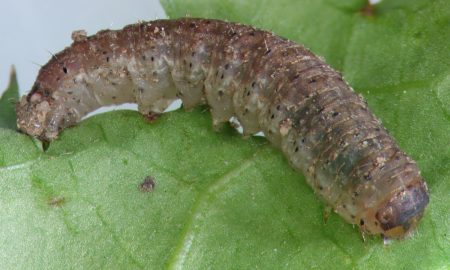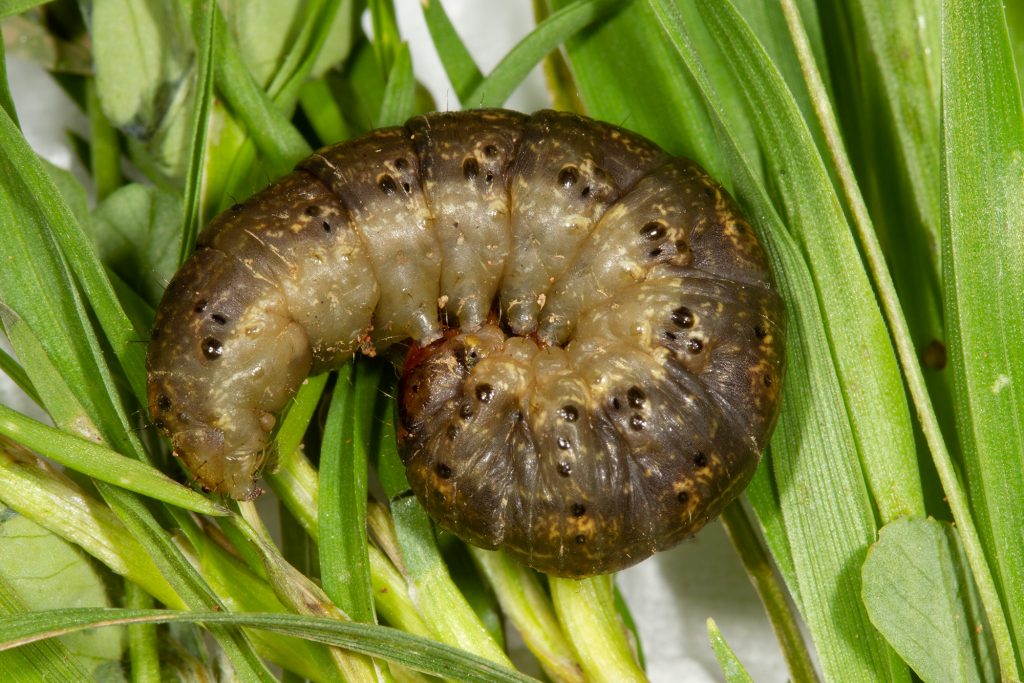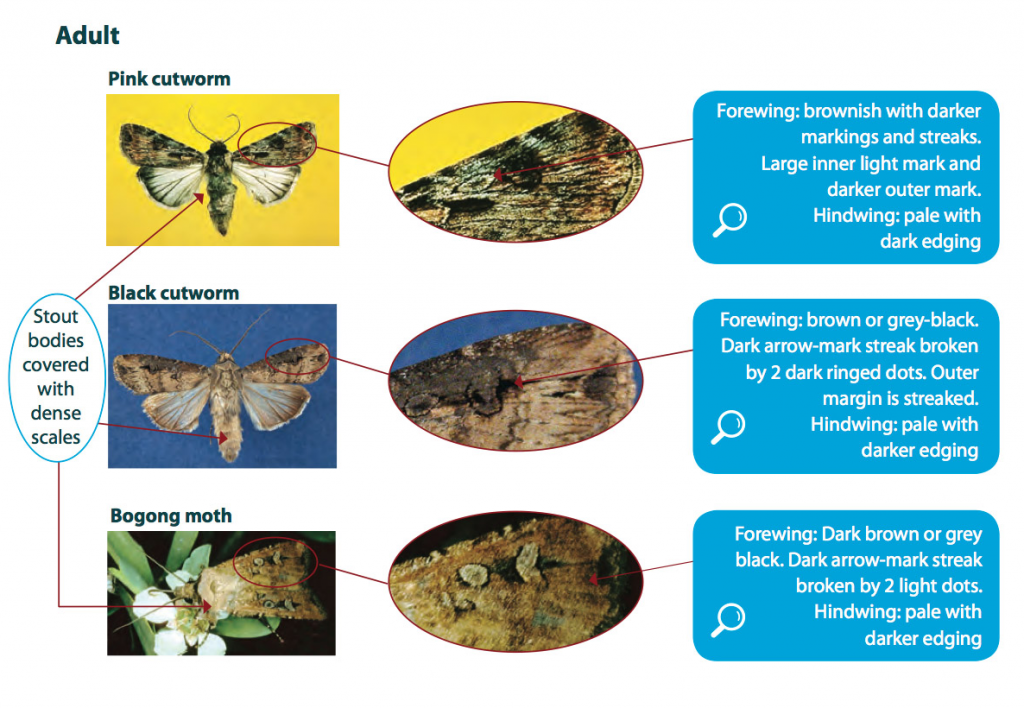Cutworm
Agrotis spp.
Other common names
Common cutworm, Black cutworm, Brown cutworm, Pink cutworm

Photo by Julia Severi, Cesar Australia
Summary Top
Cutworms are caterpillars of several species of night-flying moths, one of which is the well known bogong moth. The mature grubs are plump, smooth caterpillars. The caterpillars are called cutworms because they cut down young plants as they feed on stems at or below the soil surface. They are most damaging when caterpillars transfer from summer and autumn weeds onto newly emerged seedlings. Natural predators and early control of summer and autumn weeds will help reduce larval survival prior to crop emergence. If required, cutworms can be controlled with insecticides; spot spraying may provide adequate control.
Occurrence Top
Sporadic pests that are widely distributed in Western Australia, South Australia, Tasmania, Victoria, New South Wales and Queensland. Winter generation moths emerge in late spring and summer. Eggs are laid onto summer and autumn weeds, where larvae can then emerge onto newly sown crops.
Cutworms are a sporadic pest of all field crops and are most damaging when caterpillars transfer from summer and autumn weeds onto newly emerged seedlings.
Description Top
There are several species of pest cutworms that are all similar in appearance. Generally larvae of all species grow to about 40-50 mm long and are relatively hairless, with a distinctly plump, greasy appearance and dark head.
Moths of the common cutworm (sometimes referred to as ‘Bogong moths’) have dark brown or grey-black forewings with dark arrow markings on either wing above a dark streak broken by two lighter colour dots. Moths of the pink cutworm have grey-brown forewings with darker markings and streaks and a large inner light mark and darker outer mark. Moths of the black cutworm have brown or grey-black forewings with a dark arrow-mark streak broken by two dark ring-shaped dots.



Lifecycle Top
Eggs are laid on plant material near the soil surface. They are creamy-white when laid and take three days to several weeks to hatch depending on the temperature. The newly emerged caterpillars grow with several moults until they are full size and then pupate in the soil. Moths emerge from the pupae. It may take one month or a full year to complete a cutworm’s lifecycle depending on the species involved and temperature.

Behaviour Top
Cutworm larvae are generally nocturnal. They hide under the soil surface, soil clods or litter and come out at night to feed, although day feeding above the ground does occur occasionally, particularly when the larvae are in high densities. Caterpillars often curl up when disturbed. During the night, adult moths are strong fliers and may be seen around lights or on window panes.
Similar to Top
Cutworm larvae and adults have a broad resemblance to armyworms, the native budworm, lesser budworm and the cotton bollworm, but in each case lack the obvious stripes.
Crops attacked Top
All field crops, including cereals, pulses, oilseeds and pastures.
Damage Top
Larvae feed at ground level, chewing through leaves and stems. Stems are often cut off at the base, hence the name ‘cutworm’. Winter crops are most susceptible in autumn and winter, although damage can occur throughout the year, especially in irrigated crops. Damage mostly occurs at night when larvae are active. When numbers of larvae are high, crops can be severely thinned. Smaller larvae can cause similar damage to lucerne flea when they feed on leaf surface tissue. Young plants are favoured and are more adversely affected than older plants.
Occasionally another undescribed genus of caterpillars marked with a herringbone pattern on their abdomen inflict cutworm-like damage on emerging crops.
Monitor Top
Check crops from emergence through to establishment. Look for patchy areas or parts of the crop that have been thinned. Larvae are mostly nocturnal but some species might be found feeding in the late afternoon. During the day they hide under clods of soil or bury themselves in the soil. Check the base of recently damaged plants, and healthy surrounding plants, by scratching the soil to reveal hidden larvae.
Economic thresholds Top
Treatment of cereals and canola is warranted if there are two or more larvae per 0.5 m of row (Bailey, 2007).
Management options Top
Biological
Naturally occurring insect fungal diseases that affect cutworms can reduce populations. Wasp and fly parasitoids, including the orange caterpillar parasite (Netelia producta), the two-toned caterpillar parasite (Heteropelma scaposum) and the orchid dupe (Lissopimpla excelsa) can suppress cutworm populations. Spiders are generalist predators will also prey upon cutworms.
Cultural
As autumn cutworm populations may be initiated on crop weeds or volunteers in and around the crop, removal of this green bridge 3-4 weeks before crop emergence will remove food for the young cutworms.
If required, cutworms can be easily controlled with insecticides, and spot spraying may provide adequate control. Spraying in the evening is likely to be most effective.
Chemical
If required, cutworms can be easily controlled with insecticides. Several chemicals are registered for controlling cutworms, depending on the state and crop of registration. Spot spraying often provides adequate control in situations where cutworms are confined to specific regions within paddocks. Spraying in the evening is likely to be more effective as larvae are emerging to feed and insecticide degradation is minimised.
Acknowledgements Top
This article was compiled by Paul Umina (cesar), Garry McDonald (cesar) and Sandra Hangartner.
References/Further Reading Top
Bailey PT. 2007. Pests of field crops and pastures: Identification and Control. CSIRO Publishing, Melbourne, Australia.
Bellati J, Mangano P, Umina P and Henry K. 2012. I SPY. Insects of Southern Australian Broadacre Farming Systems Identification Manual and Education Resource. Department of Primary Industries and Resources South Australia (PIRSA), the Department of Agriculture and Food Western Australia (DAFWA) and cesar Pty Ltd.
Common IFM. 1954. A study of the ecology of the adult bogong moth, Agrotis Infusa (Boisd) (Lepidoptera: Noctuidae), with special reference to its behaviour during migration and aestivation. Australian Journal of Zoology 2: 223-263.
Common IFM. 1958. The Australian Cutworms of the genus Agrotis (Lepidoptera: Noctuidae). Australian Journal of Zoology 6: 69-88.
Green K. 2008. Migratory Bogong Moths (Agrotis Infusa) Transport Arsenic and Concentrate It to Lethal Effect by Estivating Gregariously in Alpine Regions of The Snowy Mountains of Australia. Arctic, Antartic, and Apline Research 40: 74-80.
Green K. 2010. The transport of nutrients and energy into the Australian Snowy Mountains by migrating Bogong moths, Agrotis infusa. Austral Ecology 36: 25-34.
Michael, P. 2006. Cutworms: pests of crops and pastures. Farmnote 59/1994. Department of Agriculture and Food Western Australia.
| Date | Version | Author(s) | Reviewed by |
|---|---|---|---|
| February 2015 | 1.0 | Sandra Hangartner, Garry McDonald (cesar) and Paul Umina (cesar) | Bill Kimber (SARDI) |
What are PestNotes?
PestNotes are information sheets developed through a collaboration between Cesar Australia and the South Australian Research and Development Institute (SARDI). Copyright: © All material published in PestNotes is copyright protected by Cesar Australia and SARDI and may not be reproduced in any form without written permission from both agencies.
Disclaimer
The material provided in PestNotes is based on the best available information at the time of publishing. No person should act on the basis of the contents of this publication without first obtaining independent, professional advice. PestNotes may identify products by proprietary or trade names to help readers identify particular products. We do not endorse or recommend the products of any manufacturer referred to. Other products may perform as well as or better than those specifically referred to. Cesar Australia and PIRSA will not be liable for any loss, damage, cost or expense incurred or arising by reason of any person using or relying on the information in this publication. Any research with unregistered pesticides or products referred to in PestNotes does not constitute a recommendation for that particular use.

